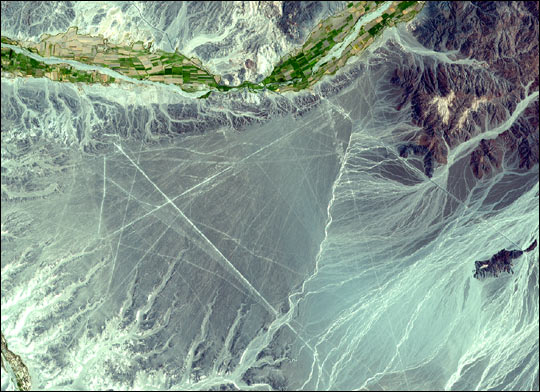
|
|
|
What's IotD? The interesting, amazing, or mind-boggling images of our days. |
|
IotD Stuff |
|
Permalink Latest Image |
|
|
|
Some folks who have noticed IotD
Neatorama |
|
Common image haunts
Astro Pic of the Day |
|
Advertising |
9/9: Nasca lines

An extraordinarily clear satellite image of Peru's Nasca lines, from the Earth Science Pic of the Day. Their caption:
The above image shows a portion of the geometric forms that compose the Nasca Lines of Peru. It was taken on December 22, 2000 from the Advanced Spaceborne Thermal Emission and Reflection Radiometer (ASTER), an instrument aboard NASA?s Terra satellite. For this image, both visible and infrared spectral bands were combined to create a simulated true-color image.
The Nasca Lines were made over 1,000 years ago by native people who lived in what is today Peru - not by extraterrestrials as suggested by some people. The Lines are located in the Pampa region of Peru, a remote desert plain near the Peruvian coast, about 400 km south of Lima. They were initially spotted when commercial airlines began flying across Peru in the 1920s. Passengers reported seeing what looked like primitive landing strips on the ground below. It was discovered later that the Lines are furrows, made by removing iron-oxide coated pebbles covering the surface of the desert. When the gravel is removed, the contrast with the lighter colors beneath can be striking. The exact purpose of the Lines is not known. Most are likely works of art but, as postulated by some archeologists, some of the Lines may mark the past location of underground sources of water.
nebby Monday Sep 10 08:55 AM
Yeah right
This is one of those things that just makes me have to think something fishy was going on. How (or why?) did humans 1000 years ago possibly construct perfectly straight lines in the Earth visible from space?
I don't see them being works of art, since I'm guessing from the ground they're nothing spectacular.
Joe Monday Sep 10 02:21 PM
Those would make really poor landing strips, they are too long,too thin and too rough. Any craft slow enough to tolerate the rough surface wouldn't need all those miles of length, any craft fast enough to need the length wouldn't be able to take landing on dirt and rocks. And they cut across the drainages, meaning they're going to be really uneven.
I bet they're some kind of primitive highway system put in place to make walking efficient across such a harsh desert. Notice how they seem to go to obvious passes before the farm country. People would leave that area carrying water, and want the absolute best route to get across the desert.
You can walk a really straight line by fixing some kind of marker to your head (hang it off your sombrero?), and lining it up on a distant target. As your marker doesn't move on your head, and the target doesn't move, and you keep them lined up, you'll walk a straight line.
dynamo Monday Sep 10 03:33 PM
roads?
I agree with Joe, why has the hypothesis of the lines being roads been discarded/overlooked?
Katkeeper Monday Sep 10 04:51 PM
I think the photograph is a work of art.
Slight Tuesday Sep 11 06:25 AM
|
...For this image, both visible and infrared spectral bands were combined to create a simulated true-color image. Earth Science Pic of the Day |
|
I think the photograph is a work of art. Katkeeper |
Also it could just be the framing. Images taken too close up, lose their context and meaning and become abtracted. I guess if I look at it that way then I could allow it to be a photograph.
Katkeeper Tuesday Sep 11 07:44 AM
The reason I like the image as art is because on my monitor and to my eye, the colors are pleasing. But most of all, I like the textural effects. And there is a lot of variety in textural effects which gives still more visual interest.
I am not trying to interpret the image at all in terms of the information conveyed when I say it is art, but only enjoying it for color, shape texture.
I hope that clarifies my statement.
jbell Thursday Sep 13 01:45 AM
I've seen similar
I've seen similar patterns in the grass of engineering campuses. All the students take the straight line from door to door as they go to the next class.
Perhaps these really are just trails in the sand.
What kind of scale are they?
-Jeff
loconet Sunday Oct 14 12:47 AM
RE: Nasca lines
Well, I dont know why the original person who posted the images did not use the good shots of the Nasca lines. The ones that really show the art work and mysterious nature of these lines..
<img src="http://www.njourneys.com/Nature%20Tours/Nazca_lines.jpg">
The Fish
<br>
<img src="http://www.exofficio.com/orvis_assets/corpimg/travjour/nazca_monkey.jpg">
The monkey
<img src="http://www.sacredtrips.com/images/nazca56.jpg">
The Bird
<img src="http://www.best.com/~gibbons/graphic/nasca_sd.jpg">
The Spider
kaleidoscopic ziggurat Monday Oct 15 12:29 PM
how do you make a straight line in the desert? despite all the resources we are constantly surrounded by - high technology and innovation - we sometimes forget the simple things... like a really long piece of string :p
Katkeeper Monday Oct 15 01:00 PM
Art work. There is an impulse in some artists to make as large a statement as possible. Like the horses cut into the chalk in England that make a really large image on a hillside, an image that had lasted hundreds of years.
I like the Peruvian ones better, however.
|
Your reply here?
The Cellar Image of the Day is just a section of a larger web community: a bunch of interesting folks talking about everything. Add your two cents to IotD by joining the Cellar. |